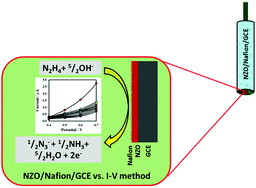Fabrication of a hydrazine chemical sensor based on facile synthesis of doped NZO nanostructure materials
Abstract
In this approach, nickel-doped zinc oxide (NZO) nanostructure materials were synthesized by the solution method in the basic phase. As-grown NZO was characterized in detail by field emission scanning electron microscopy (FE-SEM), energy dispersive X-ray spectroscopy (EDS), X-ray electron microscopy (XPS), X-ray diffraction (XRD), ultraviolet-visible spectroscopy (UV/vis), Brunauer–Emmett–Teller (BET), electrochemical impedance spectroscopy (EIS), and Fourier transform infrared spectroscopy (FTIR). A glassy carbon electrode (GCE) was modified by NZO as NZO/Nafion/GCE by the drop-coating method. The electrocatalytic activities were also studied by impedance spectroscopy (EIS) as well as cyclic voltammetry (CV) with NZO/Nafion/GCE in ferrocyanide couples. Then, the modified electrode was employed for the determination of hydrazine (HZ) by a simple and reliable electrochemical approach. Carcinogenic HZ was nominated as a target pollutant in the selectivity investigation. In this investigation for measuring HZ in the concentration range 0.20 nM to 0.02 M, the calibration plot was found to be linear (r2 = 0.9996). The sensitivity and limit of detection (LOD) values were obtained as 3.76 μA μM−1 cm−2 and 1.7 ± 0.1 pM (S/N = 3), respectively.



 Please wait while we load your content...
Please wait while we load your content...